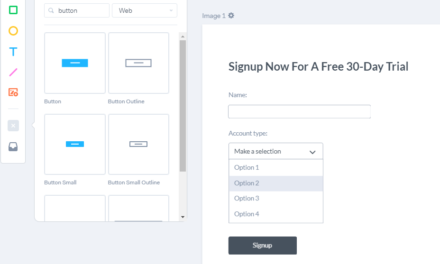This UX Research Process Will Drive Your UX Creation Process to Success
The idea of creating a good user experience (UX) covers a lot of ground. From usability to credibility and accessibility to desirability – building a positive and successful user experience isn’t simple. You need to build a journey that guides users through your content providing everything they need and seamlessly leading them through your sales funnel.
Like we said, not simple.
How does one accomplish this? Where do you start? A strong UX research process is how. Building a strong UX research process will set the foundation you need to deliver an effective user experience. We’ve broken this UX research process down into 6 steps.
Note: A lot of steps in this UX research process won’t necessarily fall solely on the UX designer. This process could involve you bringing these steps to your marketing head to attack as a team or if you’re a “one-person-show” than these steps will give you ideas on what you could do yourself or what type of information you should request from your client.
Step 1: Understanding Your Customers
This whole 6-step UX research process is all centered around your customer’s (or user’s) goals. That is the core of a good user experience. Therefore, you’ll need to know your customer’s core goals. Their goal could be that they want to improve their social media marketing, or it could be that they want to find a new restaurant in their area. Sometimes, customers don’t know what their goal is, and you need to tell them.
Either way, there are billions of customers out there all with needs and wants, so you need to know which ones fall into your customer base. You can do this by answering two questions. What problems do my customers need solved and how can we solve them? These questions can be answered by understanding your product. So, this first step is about researching internally.
You need to know the ins and outs of your product. You can’t make a good user experience by skimming over the high-level stuff. You need to understand:
- What your product does
- What are the specs/details that matter
- The variations it comes in
- What else is on the market that’s similar
- Why someone would want to buy it
Step 2: Understanding Your Customer’s Goals and Needs
Once you know your product thoroughly, you can turn into a more external exercise – knowing your customers in and out. A popular way to do this is with buyer personas. Buyer personas are fictional characters that represent the main segments of your customer base. You can establish buyer personas through surveys, focus groups, studying forums/chatroom/social media comments and looking at who your competitor’s customers are.
By the end of this first step, you’ll be able to answer those initial two questions – what problems do my customers need solved and how can we solve them? This initial research will heavily drive the UX creation process going forward.
Step 3: Identify the Factors That Will Determine if Customers Trust You to Solve Their Problem
So, you now know your customers and what their goals are. They hit your website and you got what they need, but how do they know they can trust you? You need to establish credibility. There are many ways to do this:
- Site seals that show you are a legitimate business or a recommended business
- Testimonials that show your product works for others
- Management bios that prove you’re an expert through past success and experience
- An SSL certificate, which shows customers can safely engage with your website
The items above are standard ways to build trust but if you effectively nailed step 1 and know your customers well, there might be some additional ways to build trust. Are there specific industry awards, leaders or celebrities that speak to your customer base? Is there a specific ingredient or software that would hold some clout with your customers?
Knowing these more granular details, and showcasing them, are the little things that will take your user experience up a notch.
Step 4: Make Achieving Goals with You Desirable/Attractive
For this step, you would once again turn back to your buyer personas. What do they like? If your key demographic is middle class mothers, you may want a design that evokes Pinterest or quality home shopping good brands. If your target demo is teenage girls, then basing your design off high-end fashion brands could work. Selling some type of gadget to the 18-35 male demo? Sleek, dark colors and bold imagery would be a consideration.
This step is another example of your UX research process driving your decisions during the UX creation process. This is also a good step to use the research tactic of looking at your competitors. You can pull what you like and don’t like from their branding and aesthetics.
Step 5: Make It Easy & Accessible for Customers to Find What They’re Looking For
Making an accessible user experience is all about giving your customers multiple ways to access and review content. Are you selling a product that would interest an elderly audience? Large fonts and subtitles on videos could help their user experience. Are your customers busy business professionals? Maybe offering something that is audio-focused could make it easier for them to learn about your product while at work.
Making it easy for your customers to achieve their goals is putting what’s important to them front and center. Are the credibility aspects most important? If you’re selling cybersecurity than that could be something that needs to be front and center. What pain points, benefits or features are most important? Make sure to show that front and center so it’s easy for your customers to make a decision.
Once again, your UX research process drives your UX choices.
Step 6: Help Your Customers Accomplish Their Ultimate Goal with Your UX Research Process
This part is important. You’ve done all the legwork. Time to follow through. This last part could be finalizing a conversion or following through with an effective service. If you’re building a user experience for a software as a service (SaaS) product, you want to once again refer back to your UX research process by ensuring the elements that are important to your users are easily findable.
If you’re providing a social media marketing platform, you want it to be easy to integrate with social media platforms, make posts, respond to comments, etc. All these elements should be at your user’s fingertips, and your initial research will drive a lot of these choices.
Another important item to note is that the UX research process shouldn’t ever truly stop. You should be reviewing analytics, conducting surveys, reviewing competitors and evolving the user experience along the way. If you’re seeing a large number of users disappear during a certain part of the checkout process, then use that research to alter the process.
As we said, the UX research process covers a lot of ground. By basing many of your decisions off your UX research process through these steps, it should make providing an effective user experience that much more attainable!





